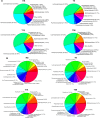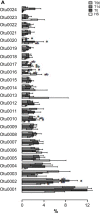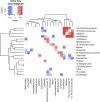Modulation of the gut microbiota composition by rifaximin in non-constipated irritable bowel syndrome patients: a molecular approach
- PMID: 26673000
- PMCID: PMC4675645
- DOI: 10.2147/CEG.S89999
Modulation of the gut microbiota composition by rifaximin in non-constipated irritable bowel syndrome patients: a molecular approach
Abstract
Rifaximin, with its low systemic absorption, may represent a treatment of choice for irritable bowel syndrome (IBS), mainly due to its ability to act on IBS pathogenesis, through the influence on gut microbiota. The aim of the present study was to assess, by biomolecular tools, the rifaximin active modulation exerted on gut microbiota of non-constipated IBS patients. Fifteen non-constipated IBS subjects were treated with 550 mg rifaximin three times a day for 14 days. Stool samples were collected before starting the treatment, at the end of it, and after a 6-week washout period. Real-time polymerase chain reaction, denaturing gradient gel electrophoresis, and next-generation sequencing were applied to all the samples to verify and quantify possible microbial fluctuations. Rifaximin treatment did not affect the overall composition of the microbiota of the treated subjects, inducing fluctuations in few bacterial groups, balanced by the replacement of homologs or complementary bacterial groups. Rifaximin appeared to influence mainly potentially detrimental bacteria, such as Clostridium, but increasing the presence of some species, such as Faecalibacterium prausnitzii. A decrease in the Firmicutes/Bacteroidetes ratio after 14 days of treatment and bacterial profiles with higher biodiversity were observed during the follow-up compared to baseline. Rifaximin treatment, although effective on IBS symptom relief and normalization of lactulose breath test, did not induce dramatic shifts in the microbiota composition of the subjects, stimulating microbial reorganization in some populations toward a more diverse composition. It was not possible to speculate on differences of fecal microbiota modification between responders vs nonresponders and to correlate the quali-/quantitative modification of upper gastrointestinal microbiota and clinical response.
Keywords: IBS; microbiota; next-generation sequencing; rifaximin.
Figures








Similar articles
-
Fecal Microbiota Alterations Associated With Diarrhea-Predominant Irritable Bowel Syndrome.Front Microbiol. 2018 Jul 25;9:1600. doi: 10.3389/fmicb.2018.01600. eCollection 2018. Front Microbiol. 2018. PMID: 30090090 Free PMC article.
-
Double-Blind Placebo-Controlled Study of Rifaximin and Lactulose Hydrogen Breath Test in Gulf War Veterans with Irritable Bowel Syndrome.Dig Dis Sci. 2019 Mar;64(3):838-845. doi: 10.1007/s10620-018-5344-5. Epub 2018 Oct 28. Dig Dis Sci. 2019. PMID: 30370492 Clinical Trial.
-
Increased Faecalibacterium abundance is associated with clinical improvement in patients receiving rifaximin treatment.Benef Microbes. 2020 Oct 12;11(6):519-525. doi: 10.3920/BM2019.0171. Epub 2020 Sep 4. Benef Microbes. 2020. PMID: 32885687
-
Rifaximin for the treatment of irritable bowel syndrome - a drug safety evaluation.Expert Opin Drug Saf. 2016 Jul;15(7):983-91. doi: 10.1080/14740338.2016.1186639. Epub 2016 May 23. Expert Opin Drug Saf. 2016. PMID: 27149541 Review.
-
Rifaximin for the treatment of diarrhoea-predominant irritable bowel syndrome.Expert Opin Pharmacother. 2015 Mar;16(4):607-15. doi: 10.1517/14656566.2015.1007951. Epub 2015 Feb 1. Expert Opin Pharmacother. 2015. PMID: 25641072 Review.
Cited by
-
Management of colonic diverticular disease in the third millennium: Highlights from a symposium held during the United European Gastroenterology Week 2017.Therap Adv Gastroenterol. 2018 May 20;11:1756284818771305. doi: 10.1177/1756284818771305. eCollection 2018. Therap Adv Gastroenterol. 2018. PMID: 29844795 Free PMC article. Review.
-
Small Intestinal Bacterial Overgrowth in Children: A State-Of-The-Art Review.Front Pediatr. 2019 Sep 4;7:363. doi: 10.3389/fped.2019.00363. eCollection 2019. Front Pediatr. 2019. PMID: 31552207 Free PMC article. Review.
-
Antibiotics: Conventional Therapy and Natural Compounds with Antibacterial Activity-A Pharmaco-Toxicological Screening.Antibiotics (Basel). 2021 Apr 7;10(4):401. doi: 10.3390/antibiotics10040401. Antibiotics (Basel). 2021. PMID: 33917092 Free PMC article. Review.
-
Diagnosis of symptomatic uncomplicated diverticular disease and the role of Rifaximin in management.Acta Biomed. 2017 Apr 28;88(1):25-32. doi: 10.23750/abm.v88i1.6360. Acta Biomed. 2017. PMID: 28467330 Free PMC article. Review.
-
Modulating the gut microenvironment as a treatment strategy for irritable bowel syndrome: a narrative review.Gut Microbiome (Camb). 2022 Aug 25;3:e7. doi: 10.1017/gmb.2022.6. eCollection 2022. Gut Microbiome (Camb). 2022. PMID: 39295774 Free PMC article. Review.
References
-
- Read NW. Irritable Bowel Syndrome. In: Feldman J, Friedman LS, Sleisenger MH, Sleisenger, Fordtran, editors. Gastrointestinal and Liver Disease: Pathophysiology/Diagnosis/Management. Philadelphia: Saunders; 2002. pp. 1794–1806.
-
- Malinen E, Rinttilä T, Kajander K, et al. Analysis of the fecal microbiota of irritable bowel syndrome patients and healthy controls with real-time PCR. Am J Gastroenterol. 2005;100(2):373–382. - PubMed
-
- Bradley HK, Wyatt GM, Bayliss CE, Hunter JO. Instability in the faecal flora of a patient suffering from food-related irritable bowel syndrome. J Med Microbiol. 1987;23(1):29–32. - PubMed
LinkOut - more resources
Full Text Sources

